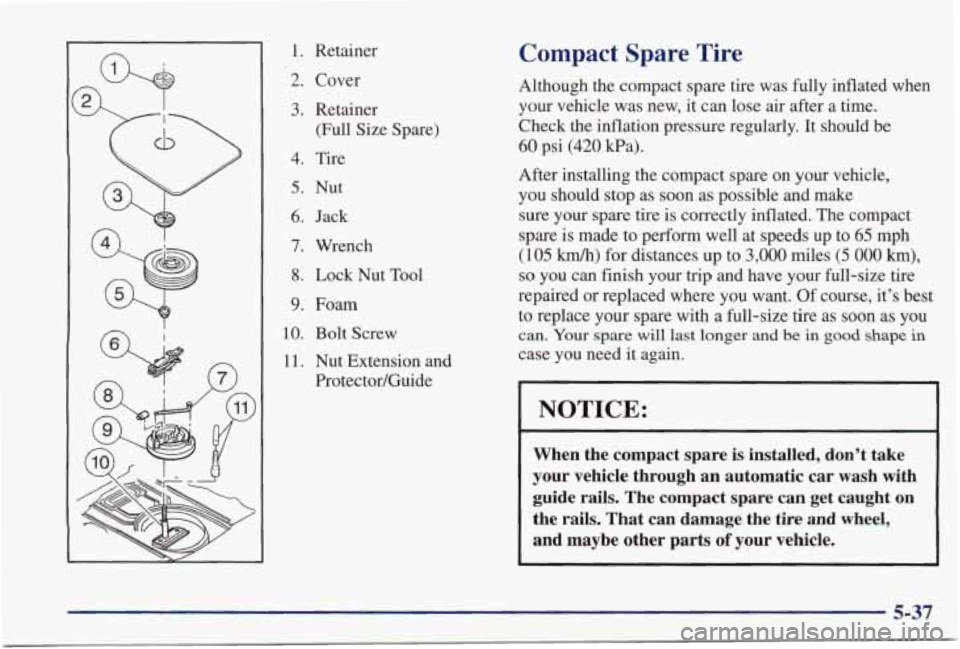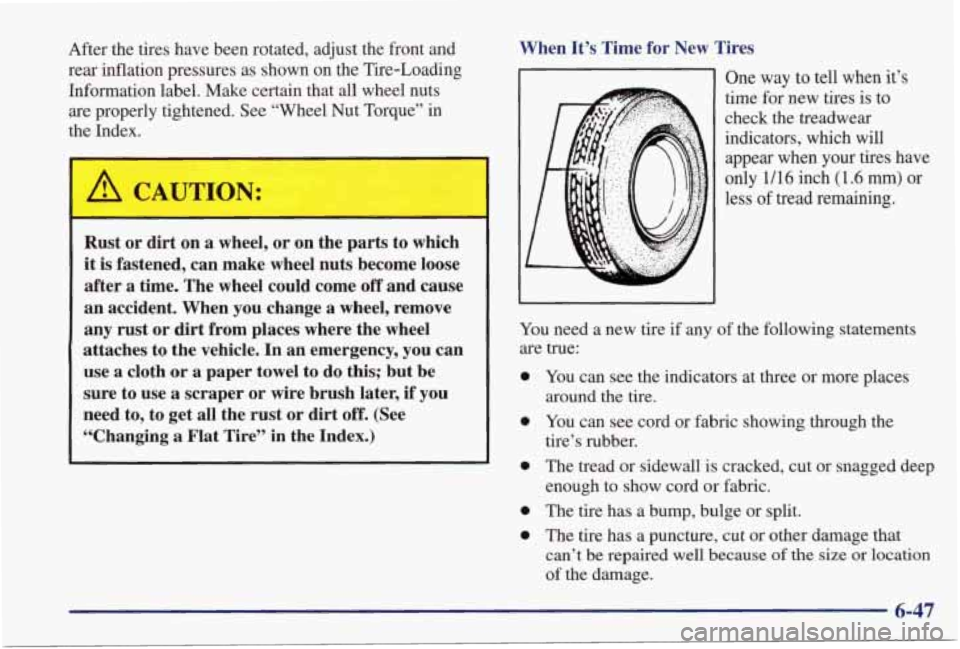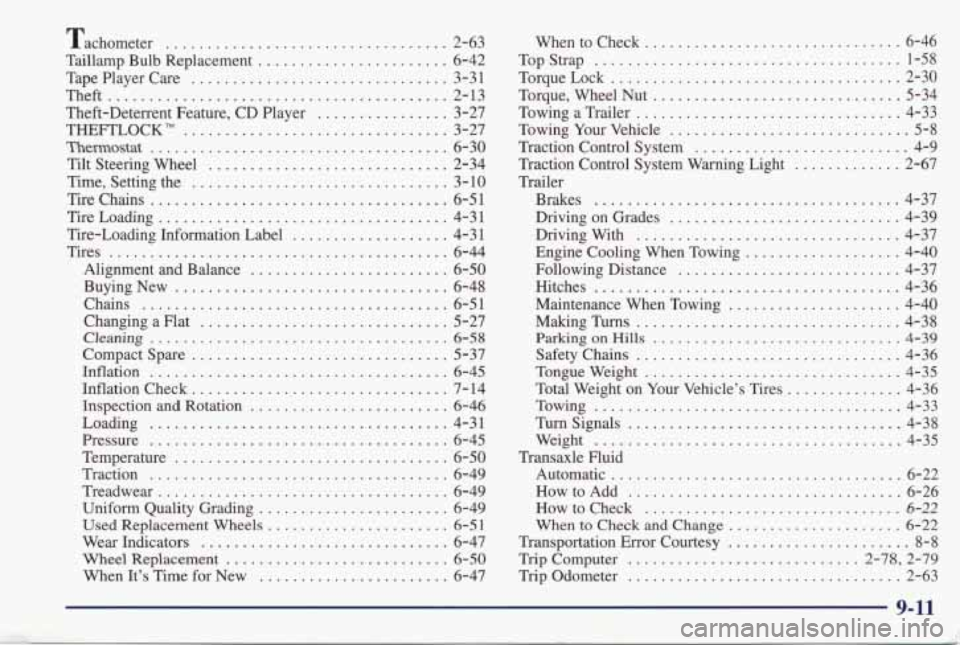1998 PONTIAC GRAND PRIX inflation pressure
[x] Cancel search: inflation pressurePage 224 of 402

Run your engine only as long as you must. This saves
fuel. When you run the engine, make it
go a little faster
than just idle. That is, push the accelerator slightly. This
uses less fuel for the heat that you get and it keeps the
battery charged. You will need
a well-charged battery to
restart the vehicle, and possibly for signaling later on
with your headlamps. Let the heater
run for a while.
Then, shut the engine off and close the window almost
all the way to preserve the heat. Start the engine again
and repeat this only when you feel really uncomfortable
from the cold. But do it as little as possible. Preserve the
fuel as long as you can.
To help keep warm, you can get
out
of the vehicle and do some fairly vigorous exercises
every half hour or
so until help comes.
Loading Your Vehicle
TIRE - LOADING INFORMATION A
OCCUPANTS
MAX. LOADING @ GVWR SAME
1 1
r
'U
IT, ADD 28KPA (4LBS)
Manual for tire pressure needed at
himlH(100 mph) or higher speeds, where legal, kr nrlrlitinnal tira inlnrmo+inn
Two labels on your vehicle show how much weight it
may properly carry. The Tire-Loading Information label
is on the inside of the trunk lid. The label tells you the
proper size, speed rating and recommended inflation pressures for the tires on your vehicle. It also gives you
important information about the number
of people that
can be in your vehicle and the total weight you can
carry. This weight is called the vehicle capacity weight
and includes the weight
of all occupants, cargo and all
nonfactory-installed options.
4-3 1
Page 272 of 402

1. Retainer
2. Cover
3. Retainer (Full Size Spare)
4. Tire
5. Nut
6. Jack
7. Wrench
8. Lock Nut Tool
9. Foam
10. Bolt Screw
11. Nut Extension and
Protector/Guide
Compact Spare Tire
Although the compact spare tire was fully inflated when
your vehicle was new,
it can lose air after a time.
Check
the inflation pressure regularly. It should be
60 psi (420 Pa).
After installing the compact spare on your vehicle, you should stop as soon as possible and make
sure your spare
tire is correctly inflated. The compact
spare is made to perform well at speeds up to
65 mph
(105 km/h) for distances up to 3,000 miles (5 000 km),
so you can finish your trip and have your full-size tire
repaired or replaced where you want. Of course, it’s best
to replace your spare with a full-size tire as soon as you
can. Your spare will last longer and be in good shape in
case you need it again.
I I
NOTICE:
When the compact spare is installed, don’t take
your vehicle through an automatic car wash with guide rails. The compact spare can get caught on
the rails. That can damage the tire and wheel,
and maybe other parts
of your vehicle.
5-37
Page 320 of 402

CAUTION: (Continued)
Underinflated tires pose the same danger
as overloaded tires. The resulting accident
could cause serious injury. Check all tires
frequently to maintain the recommended pressure. Tire pressure should be checked
when your tires are cold.
cut, punctured or broken by a sudden
impact
-- such as when you hit a pothole.
Keep
tires at the recommended pressure.
Worn, old tires can cause accidents. If your
tread
is badly worn, or if your tires have
been damaged, replace them.
Overinflated tires are more likely to be
Inflation -- Tire Pressure
The Tire-Loading Information label, which is on the
inside of the
trunk lid, shows the correct inflation
pressures for your tires when they’re cold. “Cold”
means your vehicle has been sitting for at least three
hours or driven no more than 1 mile (1.6 km).
NOTICE:
Don’t let anyone tell you that underinflation or
overinflation
is all right. It’s not. If your tires
don’t have enough air (underinflation), you can
get the following:
0 Too much flexing
Too much heat
Tire overloading
Bad wear
Bad handling
Bad fuel economy.
If your tires have too much air (overinfla
you can get the following:
Unusual wear
Bad handling
Rough ride
Needless damage from road hazards. .tion),
6-45
Page 322 of 402

After the tires have been rotated, adjust the front and rear inflation pressures as shown on
the Tire-Loading
Information label. Make certain that all wheel nuts are properly tightened. See “Wheel
Nut Torque” in
the Index.
L
Rust or dirt on a wheel, or on the parts to which
it is fastened, can make wheel nuts become loose
after a time. The wheel could come
off and cause
an accident. When you change a wheel, remove
any rust or
dirt from places where the wheel
attaches to the vehicle. In an emergency, you can
use a cloth or a paper towel to do this; but be
sure to use
a scraper or wire brush later, if you
need to, to get all the rust or dirt
off. (See
“Changing
a Flat Tire” in the Index.)
I I
When It’s Time for New Tires
.. I
One way to tell when it’s
time for
new tires is to
check the treadwear
indicators, which will appear when your tires have
only 1/16 inch (1.6 mm) or
less
of tread remaining.
YOU need a new tire if any of the following statements
are true:
0
0
0
0
0
You can see the indicators at three or more places
around the tire.
You can see cord or fabric showing through the
tire’s rubber.
The tread or sidewall is cracked, cut or snagged deep
enough to show cord or fabric.
The tire has a bump, bulge or split.
The tire has a puncture, cut or other damage that can’t be repaired well
because of the size or location
of the damage.
6-47
Page 359 of 402

Part B: Owner Checks and Services
Listed below are owner checks and services which should be performed at the intervals specified
to help
ensure the safety, dependability and emission control
performance of your vehicle.
Be sure any necessary repairs are completed at once.
Whenever any fluids or lubricants
are added to your
vehicle, make sure they are the proper ones, as shown in
Part D.
At Each Fuel Fill
It is important for you or a service station attendant to
perjiorm these underhood checks at each fuel fill.
Engine Oil Level Check
Check the engine oil level and add the proper oil if
necessary. See “Engine Oil” in the Index for
further details.
Engine Coolant Level Check
Check the engine coolant level and add DEX-COOL@
coolant mixture if necessary. See “Engine
Coohnt” in
the Index for further details.
Windshield Washer Fluid Level Check
Check the windshield washer fluid level in the
windshield washer tank and add the proper fluid
if
necessary. See “Windshield Washer Fluid” in the Index
for further details.
At Least Once a Month
Tire Inflation Check
Make sure tires are inflated to the correct pressures. See
“Tires” in the Index for further details.
Cassette Deck Service
Clean cassette deck. Cleaning should be done every
50 hours of tape play. See “Audio Systems’’ in the Index
for further details.
7-14
Page 392 of 402

Tachometer ................................ 2-63
Taillamp Bulb Replacement
....................... 6-42
TapePlayerCare
............................... 3-31
Theft
......................................... 2-13
Theft-Deterrent Feature. CD Player
................ 3-27
THEFTLOCK”
................................ 3-27
Themostat .................................. 6-30
Tilt Steering Wheel
. . .................... 2-34
Time. Setting the
............................... 3-10
Tire Chains
.................................... 6-51
TireLoading ................................... 4-31
Tire-Loading Information Label
................... 4-3 1
Tires ......................................... 6-44
Alignment and Balance
........................ 6-50
BuyingNew
................................. 6-48
Chains
..................................... 6-51
Changing a Flat
.............................. 5-27
Cleaning .................................... 6-58
Compact Spare ............................... 5-37
Inflation
.................................... 6-45
Inflation Check
............................... 7-14
Inspection and Rotation
........................ 6-46
Loading
.................................... 4-31
Pressure
.................................... 6-45
Temperature
................................. 6-50
Traction
........................ ........ 6-49
Treadwear
................................... 6-49
Uniform Quality Grading
....................... 6-49
Used Replacement Wheels
...................... 6-51
Wear Indicators .............................. 6-47
Wheel Replacement ........................... 6-50
When It’s Time for New
....................... 6-47 When to Check
............................... 6-46
TopStrap
..................................... 1-58
Torque Lock ................................... 2-30
Torque. Wheel Nut
.............................. 5-34
Towing a Trailer
................................ 4-33
Towing Your Vehicle
............................. 5-8
Traction Control System
.......................... 4-9
Traction Control System Warning Light
............. 2-67
Trailer
Brakes
..................................... 4-37
Driving on Grades
............................ 4-39
Driving With
................................ 4-37
Engine Cooling When Towing
................... 4-40
Following Distance
........................... 4-37
Hitches
..................................... 4-36
Maintenance When Towing
..................... 4-40
MakingTurns
................................ 4-38
Parking on Hills .............................. 4-39
Safety Chains ................................ 4-36
Tongueweight
............................... 4-35
Total Weight on Your Vehicle’s Tires
.............. 4-36
Towing
..................................... 4-33
Turnsignals
................................. 4-38
Weight
..................................... 4-35
Automatic
............................... 6-22
HowtoAdd
................................. 6-26
How to Check
............................... 6-22
When to Check and Change ..................... 6-22
Transportation Error Courtesy ...................... 8-8
Trip Computer ............................ 2.78. 2.79
Trip Odometer
................................. 2-63
Transaxle Fluid
9-11